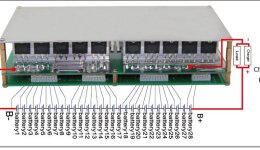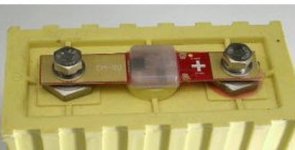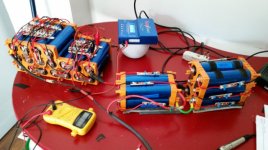johnnyz383 said:
"If you have a pack that's way out of balance, such that the charger is still delivering it's full current to the pack even though one cell has begun shunting, what current is running thru that cell (and what is running thru the pack as a whole)?"
Dont know. ...I know the bulk charger I have will shut the charge off at exactly 102.2 volts. ( 3.65 x 28 cells). This is assuming of course that each cell will get to 3.65 volts which in the real world they obviously do not.
Since these start shunting at 3.5v, then unless your charging current when at that voltage is higher than the shunting current, none of your cells will ever get higher than that.
So you'd be wasting power if your charger was set to 3.65v/cell but didn't put out more than maxshuntcurrent at 3.5v/cell, because all the cells woudl be shunting yet the charger would continue to put current thru the pack, just generating heat. (3.5vx500mA = 1.75W*28 = 49W of heat). If that's the case, you might want the charger set at #cells x shuntvoltage. That's something you may have to determine by experiment once you get the shunts and cells and charger.
If your charger provides *more* current than what is shunted, at the shuntingvoltage, then it can continue to charge even shunted cells. If that is a lot of current still flowing, then since your shunts can't be a complete BMS and actually cut off charge upon HVC, you'll need to manually monitor the voltage of each cell to be sure none go too high. Or setup the charger (if it can be) so that it does not provide too much current at that point.
"Does the BMS shut off pack charging current entirely once a cell begins shunting, if it's badly out of balance? Or does it only shut off current when the pack as a whole, balanced or not, reaches HVC?"
I dont know if near the end of the charge the bulk charger begins reducing the amps to the pack but I suspect not since there is no way it can "sense" how full the pack is unlike a smart RC charger that will bein reducing the amperage as the cell gets to full. The little modules are hooked up to each individual cell and only monitor that cell. They ONLY shunt the voltage when it reaches 3.5 volts on that cell its attached to. They have nothing to do with the bulk charger itself. As I understand it, it DIVERTS or SHUNTS the current to a "resistor" therby limiting the current to the cell so that in theory the others if close in voltages can catch up. It DOES NOT shut the voltage off to the cell.
And so, as noted above, you'll want to manually monitor cell voltages during charge. If everythign is well-balanced, it won't matter, but if it is not, that's where a shunt-only BMS creates a risk, because there is nothing except you to stop it from overcharging a cell or cells.
If your charger somehow can keep full amps going even though cells are shunting, if you have a badly-unbalanced situation, then you could have a real problem at hand. Probably it does not keep full amps going, and probalby curves down the amps as voltage rises, but unless you know how it works, you are basically charging without any idea what's happening in the pack.
With some chemistries, that has (probably) caused fires. Don't know if there's a documented case with your cell type or not.
The pack is close in voltages, and by that i mean each is within .09 of a volt...so for example one cell might be 3.25 and the next highest r lowest would be no more or less than 3.34 or 3.16 bu that would only apply to one or two cells most are within .04 of a volt.
Right now, yes. But...as it ages and especially upon deep discharges, that will be less and less true. That's when a cell-monitoring BMS comes in real handy, so you don't have to remember do that yourself, during charge *and* discharge.
"If you have a pack that is almost perfectly balanced, and all but a few cells are shunting, the rest nearly at full charge, with the charger only supplying 130mA of current, what current is running thru the shunted cells? What current is running thru the shunts? What current is running thru the unshunted cells?"
I dont know what the current running through the shunted cells are...but if all are over 3.55 volts then all of the shunts would be in operation allowing the lower cells to "catch up". So in other words, if it take a cell 1 min to reach 3.7 volts given a charge of 5 amps from 3.55 volts, then obviously when shunted the cell is now not getting full amperage and this may now take 3 mins or 5 mins...im not sure hence my question.
Let's say you have cells that are out of balance by quite a bit (this is going to eventually happen, when will depend on various factors). You've got some that drop as much as a whole Ah less capacity than others, so after some are full and start shunting, then others are going to take the amount of time 1Ah takes to get in there, given whatever the current delivered by teh charger is at that voltage.
Let's pretend that's 1A, for ease of numbers. The not-yet-full cells will take another hour *at that rate* to fill up... It's twice what the shunts can pull aside from the already-full cells, so for at least an hour they will continue to be charged. But it won't actually be an amp for that whole time, it'll probably drop as the voltage of the cells rises. So it will take even longer than an hour. How long? dunno, that depends on the current and voltage curves the charger can deliver and how the cells respond and continue to rise in voltage.
Dunno how it would relaly work out with your cells, shunts, and charger.
So...it's still not a question we can directly answer for you. Unless you have the data available already, you'd have to do experiments to determine the numbers.
I hope there is now enough information so that someone can answer my question as to why the shunts did work...when the cells had been partially discharged and more out of balance then when they were all charged to 3.55 volts and did not work allowing the charge to go past 3.99 volts. (They all have a resettable fuse that will blow when the voltage goes past 4 volts saving the shunt from overheating that is, if the current is greater than 500 mah and continues so that the cell gets past 4 volts.
So teh BMS will then protect itself, and not the cell it was meant to?
That sounds like a bad idea. What if the pack is so unbalanced for whatever reason that a cell causes that condition, and the charger is still charging? The shunt isn't doing anything to protect the cell then, whcih will continue to climb in voltage, preventing the shunt from resetting and doing it's job again. I don't know what the charge curve of thsoe cells is, or at what point they would begin internally heating from the overvoltage with current still flowing.
But what if the cell heated enough from that to cause distortion or melting of insulating materials? As long as you have non-meltable insulation outside the cell, that wouldn't be too bad, until it begins heating the other cells around it, etc., but what happens if the cell heats internally until something fails?
I think that with that mechanism in teh shunt, you will want even more to monitor individual cell voltages so that the charger will automaticlaly shut off if that happens.
That cell-level monitoring is one of the more important parts of a BMS. Even one that does no balancing at all but still shuts off discharge at cell-LVC and charge at cell-HVC would be better, because you could see by capacity monitoring that it is not balanced, even if there were no other indications, and you could fix it manually if you had to.
One that only balances but does not monitor or have any safety cutoffs is going to let you keep overcharging some cells and undercharging others, and is never going to even let you know this is happening. Without an LVC you will be able to overdischarge those undercharged cells, and wihtout an HVC the charger will overcharge the overcharged cells. Eventually something will fail, hopefully wihtout drama...but I would not bet anything on it, and give the possible risks, I would not do that.
Basically, the point was to show you that unless you have the information already, we can't know what it is either. And that you can't know the state of the pack with those, cuz they don't know, as none talks to the others or the charger, so you have a bunch of people laying down in a sealed room, blindfolded holding buckets and a hose filling them at some unknown rate, with not much to stop the hose from overfilling the buckets and eventually drowning some of those people.





